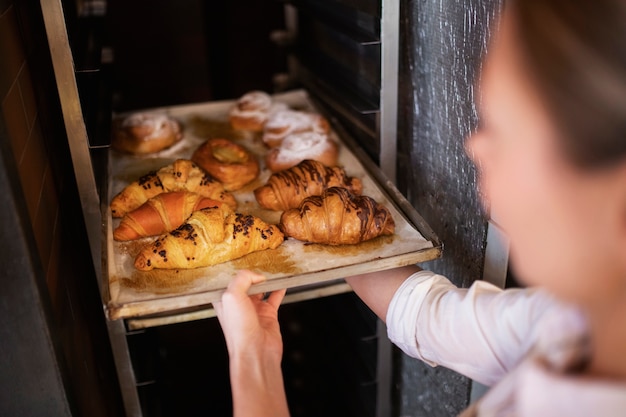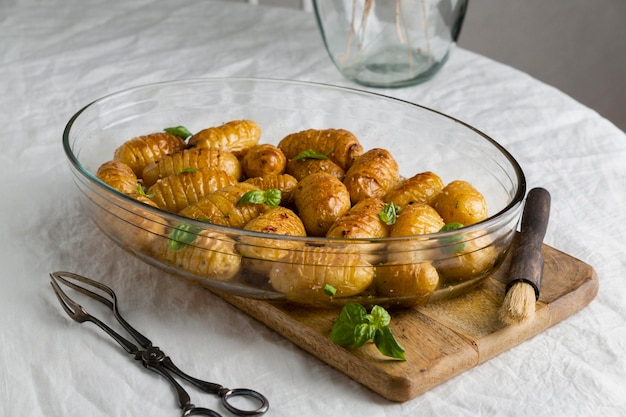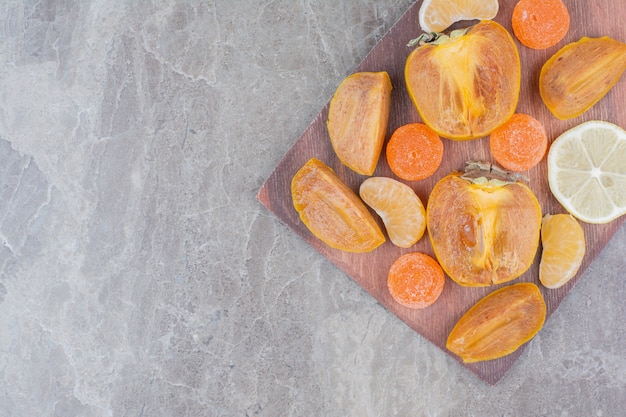Ah, sweet potatoes! They're one of those comforting vegetables that make everything feel a bit more special. From those crispy sweet potato fries to the warm, gooey sweetness of a sweet potato pie, there's something about their earthy flavour and creamy texture that just hits the spot. But I'll be honest, I've had my fair share of sweet potato disasters. We've all been there – the soggy, undercooked, or even worse, burnt, sweet potato.
But fear not, my fellow food enthusiasts! I'm here to share my hard-earned wisdom and guide you to sweet potato nirvana. Once you unlock the secrets of perfect oven-baked sweet potatoes, you'll be churning out delicious, fluffy, and perfectly roasted spuds every single time. Let's embark on this culinary journey together!
(Part 1) The Sweet Potato Selection

First things first, we need to pick the right sweet potatoes. I used to think they were all the same, but let me tell you, there's a world of difference. You want to look for sweet potatoes that are firm to the touch and free from any blemishes or soft spots. A little bit of visual inspection goes a long way.
Choosing the Right Variety: A Sweet Potato Spectrum
Here's where things get truly interesting – the world of sweet potatoes is a diverse one. Each variety has its own unique flavor profile and texture. It's like picking out a vintage wine; you want to choose the right one for your culinary masterpiece.
- Garnet: This is the classic sweet potato, with a deep orange flesh and a sweet, slightly tangy flavor. It's a workhorse in the kitchen, perfect for roasting, mashing, or even adding to your favorite soup.
- Beauregard: This variety is known for its vibrant orange flesh and a rich, intensely sweet flavor that's almost like a candy bar. It's a baking superstar, ideal for pies, cakes, and anything where you want that extra sweetness.
- Covington: This lighter orange sweet potato has a mild flavour and a smooth, creamy texture. It's the perfect choice for those who prefer a subtle sweetness, and it works beautifully in mashed sweet potatoes or soups.
Personally, I love using a mix of Garnet and Beauregard for roasting. The Garnet provides a great foundation, while the Beauregard adds a touch of decadent sweetness and richness. It's like the best of both worlds!
Size Matters: From Tiny to Jumbo
The size of your sweet potato will also play a role in the baking time. Smaller sweet potatoes will take less time to bake, while larger ones will require a longer baking time. You can even cut larger sweet potatoes in half to ensure even cooking. No one wants one side perfectly roasted while the other is still raw!
(Part 2) Prepping for Perfection

Once you've chosen your perfect sweet potatoes, it's time to get them ready for the oven. I like to give them a good scrub with a vegetable brush to remove any dirt or debris. A clean canvas is essential for a delicious outcome.
The Great Debate: To Peel or Not to Peel?
Ah, the age-old question! For years, I was a purist and peeled every sweet potato. But then I discovered the beauty of the skin. It adds a lovely texture and a subtle earthy flavor that elevates the whole experience.
So, do you peel or not? It's entirely up to your personal preference. If you prefer a smooth and silky sweet potato, then peeling is the way to go. However, if you're open to a bit of rustic charm and some extra flavour, leave the skin on. Just make sure to give it a good scrub to remove any dirt if you're keeping it on.
Cutting for Even Cooking: A Uniform Symphony
For even cooking, I prefer to cut my sweet potatoes into similar-sized chunks. It helps ensure that they all bake at the same rate. No one wants a mushy sweet potato next to a crunchy one, right? It's all about that beautiful harmony of textures!
(Part 3) Unveiling the Secrets of Perfect Roasting

Now, here's where the magic happens! The key to perfect roasted sweet potatoes lies in finding the right combination of heat, time, and moisture. It's a culinary dance that requires a touch of intuition and a bit of practice.
Oven Temperature: The Sweet Spot for Caramelization
Through trial and error, I've found that a medium-high oven temperature, around 400°F (200°C), is the sweet spot for roasting sweet potatoes. It allows them to develop that lovely caramelization on the outside while staying fluffy and moist on the inside. It's a delicate balance, but worth the effort!
Baking Time: A Guide to Golden Perfection
This is where things get a bit more nuanced. The baking time can vary depending on the size and thickness of your sweet potato chunks. It's like a baking puzzle, where you need to consider all the pieces.
Here's a general guideline that can get you started:
| Size of Sweet Potatoes | Baking Time |
|---|---|
| Small (1-inch cubes) | 20-25 minutes |
| Medium (2-inch cubes) | 30-35 minutes |
| Large (3-inch cubes) | 40-45 minutes |
But remember, these are just estimates. The best way to tell if your sweet potatoes are done is to give them a good poke with a fork. If it slides in easily and the flesh is tender, then you're ready to celebrate.
Moisture Matters: Creating a Culinary Oasis
You're probably wondering, what about moisture? Well, that's where the real magic comes in. I like to toss my sweet potato chunks with a little bit of olive oil and a sprinkle of salt and pepper. The olive oil helps create a crispy, caramelized exterior, and the salt and pepper enhance the natural sweetness of the sweet potato. It's a delicious symphony of flavours!
But here's a little secret: adding a splash of water to the baking dish will help create a moist environment for the sweet potatoes to bake in. This helps prevent them from drying out and becoming too hard. It's like giving them a little spa treatment while they're roasting.
(Part 4) Flavor Explorations: The Art of the Sweet Potato Roast
Now, let's talk about flavor! You can keep things simple with just salt and pepper, but I like to get a little creative and experiment with different herbs and spices. It's like creating your own flavor masterpiece!
Classic Sweet Potato Roast: A Time-Honored Tradition
For a classic sweet potato roast, I like to use a combination of:
- Rosemary: A touch of herbaceous elegance.
- Thyme: Adds a warm, earthy depth.
- Garlic powder: A subtle but impactful aroma.
- Cayenne pepper: A whisper of heat for those who like it spicy.
This combination is a classic for a reason. It creates a balanced and comforting flavour that complements a wide range of dishes.
Sweet and Spicy: A Taste of Adventure
If you like things a little more fiery, try adding a sprinkle of:
- Chili powder: A warm, smoky flavour that adds a touch of intrigue.
- Paprika: A vibrant red spice with a slightly sweet and peppery note.
- Cumin: Earthy and warm, perfect for adding depth to your roast.
- Cinnamon: A touch of sweetness and warmth that pairs perfectly with the natural sweetness of the sweet potato.
This combination is perfect for those who love a bit of a kick. It's a bold and exciting flavour that's sure to impress.
Sweet and Savory: A Delicious Fusion
For a sweet and savory twist, try adding:
- Maple syrup: A touch of natural sweetness that complements the sweet potato beautifully.
- Brown sugar: Adds a caramel-like richness to the roast.
- Soy sauce: A hint of umami that elevates the sweet potato's natural flavors.
- Ginger: A subtle spice that adds a touch of warmth and complexity.
This combination is a culinary adventure, blending sweet and savory flavors in a way that's both delicious and unexpected.
The possibilities are truly endless. Just experiment and see what flavor combinations tickle your fancy! Remember, cooking is an art, and there's no right or wrong way to do it. It's all about having fun and creating something delicious.
(Part 5) A Step-by-Step Guide to Sweet Potato Nirvana
Now, let's put all this knowledge into practice. Here's my step-by-step guide to perfect roasted sweet potatoes, so you can confidently create a culinary masterpiece in your own kitchen.
Step 1: Preheating and Preparing the Sweet Potatoes
Preheat your oven to 400°F (200°C). This will ensure that your sweet potatoes roast evenly and develop that lovely caramelization on the outside. While the oven is preheating, wash and scrub your sweet potatoes thoroughly. If you're peeling, peel them now and cut them into even-sized chunks.
Step 2: Tossing with Seasonings: A Culinary Embrace
Place your sweet potato chunks in a large bowl. Drizzle with olive oil and season with salt, pepper, and your desired herbs and spices. Use your hands to toss them gently, ensuring each piece is coated evenly. It's like giving them a little culinary massage, preparing them for their transformation in the oven.
Step 3: Spreading for Even Cooking: A Single Layer of Sweetness
Spread the sweet potatoes in a single layer on a baking sheet. Make sure they're not overcrowded, or they won't cook evenly. They need their own space to breathe and develop that beautiful caramelized crust.
Step 4: Baking to Perfection: A Symphony of Heat and Time
Bake for 30-45 minutes, or until the sweet potatoes are tender and slightly caramelized on the edges. Check them every 10 minutes to make sure they're not burning. It's a delicate dance, so keep a close eye on them!
Step 5: Serving with Delight: A Culinary Triumph
Once they're done, remove the sweet potatoes from the oven and let them cool for a few minutes. Serve warm and enjoy! You've just created a culinary masterpiece that will delight your taste buds and impress your guests.
(Part 6) Serving Up Sweet Potato Perfection: A Feast for the Senses
Now that you've mastered the art of roasting sweet potatoes, it's time to unleash your culinary creativity. They're incredibly versatile and can be enjoyed in a variety of ways. Let your imagination run wild and explore the possibilities!
A side dish Delight: Completing the Culinary Canvas
Roasted sweet potatoes are a perfect accompaniment to any main course, from grilled chicken or fish to roasted vegetables or hearty stews. Their sweet and savory flavor adds a delightful touch to any meal. They're like the missing piece of the puzzle, bringing everything together in perfect harmony.
sweet potato salad: A Burst of Flavor and Texture
Toss your roasted sweet potatoes with a tangy vinaigrette, chopped pecans, and crumbled feta cheese for a delicious and satisfying salad. The combination of sweet, savory, and crunchy textures will keep your taste buds engaged. It's a light and refreshing dish that's perfect for any occasion.
Sweet potato soup: A Warm Embrace
Puree roasted sweet potatoes with vegetable broth, coconut milk, and a pinch of ginger for a comforting and creamy soup. It's the perfect way to warm up on a chilly evening. The sweet potato's natural sweetness is enhanced by the coconut milk and ginger, creating a harmonious blend of flavors that's both comforting and delicious.
Sweet Potato Fries: A Crispy and Delicious Treat
Slice roasted sweet potatoes into fries and bake them until crispy for a healthy and satisfying snack. They're a great alternative to traditional potato fries, offering a unique sweetness and a delightful crispy texture. It's the perfect treat for movie nights, game days, or any time you're craving a delicious snack.
(Part 7) Troubleshooting: Conquering Culinary Challenges
We've all been there. You've followed the recipe, you've done everything right, but your sweet potatoes just aren't turning out the way you hoped. Don't worry, it happens to the best of us! It's part of the culinary journey.
Soggy Sweet Potatoes: Seeking that Perfect Texture
If your sweet potatoes are soggy, it's likely that they didn't have enough time to roast in the oven. Make sure to check the internal temperature of the sweet potatoes with a thermometer. They should reach an internal temperature of 210°F (100°C). If they're not quite there, pop them back in the oven for a few more minutes.
Hard Sweet Potatoes: Restoring Moisture and Tenderness
If your sweet potatoes are hard, it's likely that they were overcooked. Overcooked sweet potatoes can become dry and hard. You may need to add a bit of water to the baking dish to help them stay moist. You can also try adding a splash of broth or even a little bit of honey or maple syrup to add some moisture and sweetness.
Burnt Sweet Potatoes: Preventing Disasters in the Kitchen
If your sweet potatoes are burnt, it's likely that they were cooked at too high of a temperature or for too long. Make sure to keep a close eye on them in the oven. You can try reducing the oven temperature slightly or checking them more frequently to prevent them from burning.
Don't be discouraged! Just adjust your technique and try again! It's all part of the learning process, and every culinary experience is a chance to learn and grow.
(Part 8) sweet potato storage Tips: Preserving Your Culinary Treasure
Sweet potatoes are a great pantry staple, but it's important to store them properly to keep them fresh and delicious.
Storing Sweet Potatoes: A Culinary Sanctuary
Store uncooked sweet potatoes in a cool, dark, and dry place, such as a pantry or cupboard. Avoid storing them in the refrigerator, as this can cause them to become cold and starchy. They're best kept at room temperature, where they can retain their sweetness and texture.
Freezing Sweet Potatoes: Preserving for Future Delights
You can freeze cooked sweet potatoes for later use. Simply cool them completely, then place them in a freezer-safe bag or container. Frozen sweet potatoes can be used in soups, stews, or baked goods. They're a great way to have a healthy and convenient ingredient on hand for busy weeknights.
FAQs: Addressing Your Sweet Potato Queries
Here are a few frequently asked questions about baking sweet potatoes, to help you navigate this culinary adventure with ease.
- Q: Can I bake sweet potatoes in the microwave?
- A: While you can bake sweet potatoes in the microwave, the texture won't be as nice as when they're roasted in the oven. The microwave tends to make them more mushy and less flavorful. For that perfect roasted texture, stick to the oven.
- Q: Can I use foil when baking sweet potatoes?
- A: Yes, you can use foil to wrap your sweet potatoes while they bake. This will help them to cook more evenly and stay moist. However, if you want a crispy exterior, you'll want to bake them uncovered for the last few minutes of cooking time. It's like giving them a little sunbath at the end of their roasting session.
- Q: How can I tell if my sweet potatoes are done?
- A: You can tell if your sweet potatoes are done by giving them a poke with a fork. If it slides in easily and the flesh is tender, then they're ready. You can also check the internal temperature with a thermometer. The sweet potatoes should reach an internal temperature of 210°F (100°C).
- Q: What can I do with leftover roasted sweet potatoes?
- A: Leftover roasted sweet potatoes are a great addition to salads, soups, stews, or breakfast bowls. You can also puree them and use them as a base for sweet potato pancakes or muffins. They're incredibly versatile and can be used in a variety of dishes.
- Q: How long can I store roasted sweet potatoes in the refrigerator?
- A: You can store roasted sweet potatoes in the refrigerator for up to 3 days. They'll retain their flavor and texture for a few days, so you can enjoy them in various meals.
There you have it, my friends! With a little bit of knowledge, practice, and a sprinkle of culinary intuition, you can be roasting perfect sweet potatoes every single time. Go forth and conquer the world of sweet potatoes!
Everyone is watching

Perfect Rice Every Time: The Ultimate Guide to Cooking Rice
Cooking TipsAs a self-proclaimed foodie, I've always been a bit obsessed with rice. It's the foundation of countless cuisi...

Prime Rib Roast Cooking Time Chart: Per Pound Guide
Cooking TipsPrime rib roast. Just the name conjures images of lavish dinners, crackling fires, and hearty laughter. It’s ...

The Ultimate Guide to Cooking Asparagus: Tips, Techniques, and Recipes
Cooking TipsAsparagus. The mere mention of this spring delicacy conjures up images of vibrant green spears, crisp and burs...

Ultimate Guide to Cooking the Perfect Thanksgiving Turkey
Cooking TipsThanksgiving. Just the word conjures up images of overflowing tables laden with delicious food, the scent of r...

How Long to Bake Potatoes in the Oven (Perfect Every Time)
Cooking TipsBaked potatoes are a staple in my kitchen. They're incredibly versatile, delicious, and surprisingly easy to m...
